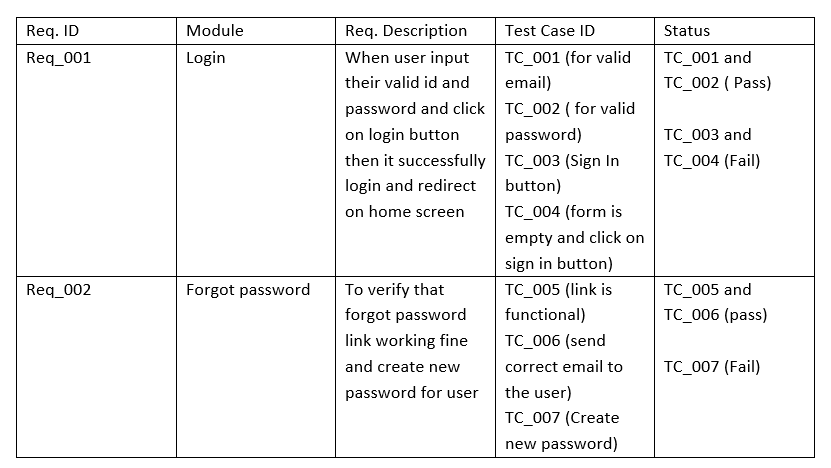| Usama Muhammad
What is Traceability Matrix?
A traceability matrix is a document that correlates any two baseline documents which require a many-to-many relationship to verify the completeness of the Project or Product relationship .The basic purpose of this matrix to track the requirements of any particular project.
What is Requirements Traceability Matrix (RTM)?
Requirements traceability is a matrix that map and trace the user or client requirements with test cases. As you see the definition of traceability matrix, correlates any two baseline documents which require many-to-many relationship to achieve its goal. That’s why RTM captures all the requirements of the clients or users for particular project and create test cases according to it. The basic purpose of the RTM is to validate all requirements via test cases. Requirements have a relationship with test cases to complete it. Basically, RTM is a GPS of Quality Assurance Engineer, if it is used in a right direction.
Why RTM is Important?
The first and most important responsibility of QA is to understand the client requirements and make sure that the output product is bug free. With the help of requirements understanding QA will create positive and negative test cases to validate the product or project. Requirements traceability matrix assures good “Quality” of the application or software as all features are tested. It helps us to create a link between requirements, test cases and defects accurately. With the help of RTM bugs or defects caught in earlier stage. A simple way is to trace the requirements with its corresponding test scenarios and test cases. This merely is termed as “Requirements Traceability Matrix” It is a type of worksheet that contains requirements with its all possible test scenarios and test cases and their current state either they have been passes or failed or In-progress. This would help the testing team to understand the level of testing activities done for the specific product. Basically, RTM helps the testing team, development team and also a project manager to track the requirements with its test cases and bugs. It also helps to make sure that the final product is defect or bug free and would give high quality.
Types of Requirements Traceability Matrix
In Software engineering requirements traceability matrix can be divided into three main types:
- Forward Traceability: Forward traceability matrix is used to map the requirements to the test cases. It is also used to check the progress of project in the desired direction and for the right product. It makes sure that each requirement is applied to the product and that each requirement is tested thoroughly.
- Backward Traceability: It is used to makes sure that the current product is in the right track. Backward traceability matrix is used to map the test cases with the requirements. The purpose of this traceability matrix is to verify that we are not adding any extra functionality, design, test or other work which are not specified in the requirements.
- Bi-directional Traceability: It is the combination of both forward and backward traceability matrix. It ensures that all requirements are covered by test cases. It analyzes the impact of change in requirements affected by the defect in a word product or vice versa.
How to Create Requirements Traceability Matrix?
First, of all we need to identify the parameters which are required to create RTM in a right way. There are some parameters which are required to create RTM:
- Req. ID
- Req. Type and description
- Test Case Id
- Status
Let’s take an example of Microsoft login form from the given below pictures.


User enter valid email id and Password then click on Sign In button, it will redirect on home page
Forgot password link is working

Conclusion
Requirement Traceability Matrix is very important in the entire process of Quality Assurance. It is the artifact which will give at the end of the product completion to verify that either all the requirements of the client or user were met or not. It is the best way to track the requirements and their related bugs with the help of test cases. It helps the QA team to identify bugs easily.
Learn more about Imperium's Power App Services. We hope this information was useful, and we look forward to sharing more insights into the Power Platform world.

